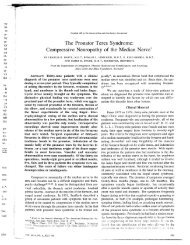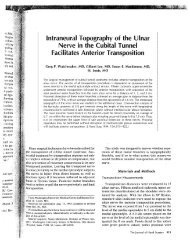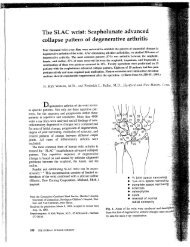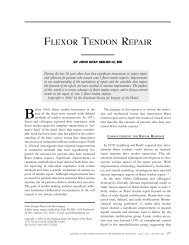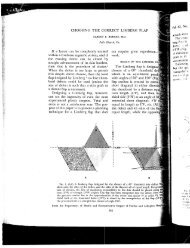Radiocarpal Dislocation Classification Rationale for Management and
Radiocarpal Dislocation Classification Rationale for Management and
Radiocarpal Dislocation Classification Rationale for Management and
You also want an ePaper? Increase the reach of your titles
YUMPU automatically turns print PDFs into web optimized ePapers that Google loves.
FIG. 1.<br />
<strong>and</strong> lateral rad<br />
showin<br />
of the entire carpus or~<br />
distal radius. Note the<br />
sence of a fracture ofl<br />
distal radius <strong>and</strong><br />
maintenance of<br />
intercarpal relation.<br />
is Type I dislocation.<br />
er general anesthesia<br />
)cation was conducted<br />
, stepoff of the radial styloid i<br />
ion <strong>and</strong> internal fixation of<br />
ture was per<strong>for</strong>med (Fig. 5)<br />
:ept in a cast <strong>for</strong> six weeks.<br />
:he injury (Fig. 6) he had<br />
total score of 100. His ulnar<br />
ne months after injury <strong>and</strong> ~.<br />
~ntinuity. It was completely<br />
IS.<br />
~ld male rancher injured his<br />
FIG. 2. Anteroposterior<br />
<strong>and</strong> lateral radiographs<br />
of the patient in Fig.<br />
1 showing satisfactory<br />
closed reduction of the<br />
dislocation.<br />
1985<br />
i, FIG. 3. Follow-up raof<br />
the patient<br />
Fig. 1 showing residual<br />
ion of the carpus<br />
no arthritic changes<br />
maintenance of the<br />
bones relation. A<br />
mired fracture of the<br />
styloid is also evi-<br />
wrist when he attempted to brace himself<br />
nst a loading dock when he was pushed up<br />
against it by a truck. On his arrival at the emergency<br />
:room obvious de<strong>for</strong>mity of the right wrist was<br />
md. The h<strong>and</strong> was lying volar to the <strong>for</strong>earm.<br />
i~Radiographs of the h<strong>and</strong> revealed a volar radio-<br />
~¢arpal fracture-dislocation with severe volar dis-<br />
: placement of the lunate <strong>and</strong> the scaphoid (Type II<br />
) (Fig. 7). There was also a 7-mm scapholunate<br />
gap. Closed reduction was unsuccessful <strong>and</strong><br />
the patient was taken to the operating room <strong>for</strong><br />
open reduction under axillary block anesthesia.<br />
~Both a volar carpal tunnel release incision <strong>and</strong> a<br />
’IS!dorsal longitudinal incision were made. At the time<br />
FIG. 4. Anteroposterior<br />
<strong>and</strong> lateral radiographs<br />
showing a dorsal radiocarpal<br />
fracture dislocation.<br />
Note the mainte-<br />
dislocation.<br />
<strong>Radiocarpal</strong> <strong>Dislocation</strong><br />
203<br />
of ° surgery the lunate was found to be rotated 180<br />
on the distal radius <strong>and</strong> its capsular attachments<br />
to the radius were intact. There was a severe tear<br />
at the volar midcarpal level between the lunate <strong>and</strong><br />
the capitate that extended radially into the radiocapitate<br />
<strong>and</strong> radiolunate ligaments <strong>and</strong> ulnarly into<br />
the triquetrocapitate ligament. On the dorsal side<br />
the capsular ligaments between the radius <strong>and</strong> the<br />
scaphoid <strong>and</strong> lunate were torn. The scapholunate<br />
intercarpal ligament was completely torn <strong>and</strong> there<br />
was a fracture of the articular surface on the head<br />
of the capitate. The dislocation was reduced with<br />
some difficulty. Pins were used to fix the radial<br />
’styloid to the radius; two additional pins were used



